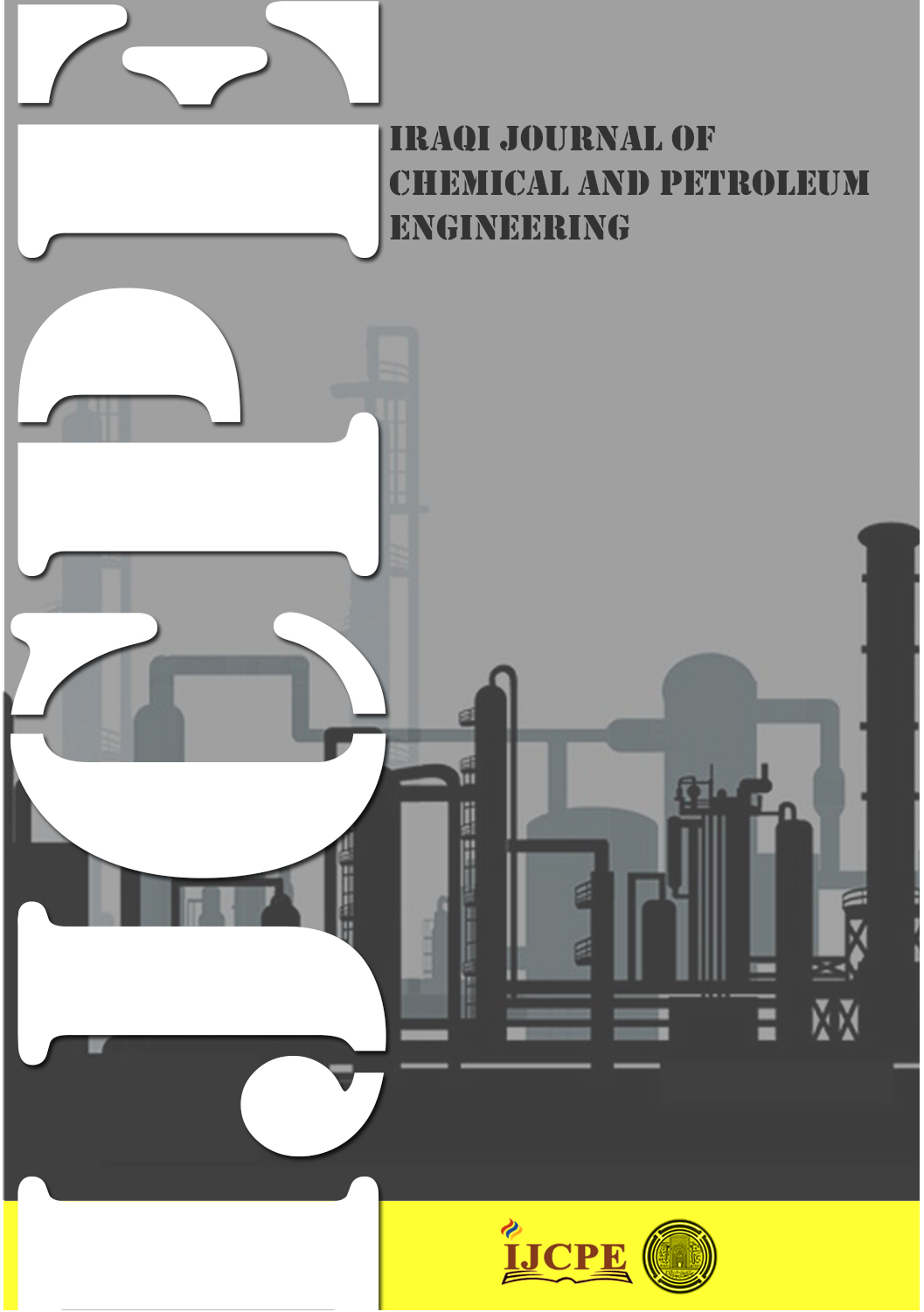Investigation of the effects of chitosan-zinc nanoparticles Ch-ZnO NPs on phenotypic biofilm formation of Acinetobacter baumannii and cytotoxicity assay
DOI:
https://doi.org/10.31699/IJCPE.2025.1.8Keywords:
Acinetobacter baumannii; Biofilm, Chitosan; Nanocomposites; Zinc oxideAbstract
The research aimed to create chitosan zinc oxide nanoparticles (Ch-ZnO NPs) for use as agents to combat biofilms produced by Acinetobacter baumannii. The Ch-ZnO NPs were produced using chitosan biomass as a cost-effective, eco-friendly material for synthesis purposes. The properties of the produced nanoparticles were analyzed through a range of methods. Fourier transform infrared spectroscopy (FTIR) carried out chemical structure identification and analysis. The maximum absorption peak, at 235 nm was confirmed through UV spectrophotometry. The X-ray diffraction (XRD) varied the hexagonal crystal structure with a particle size measurement of 34 nm. Surface morphology was probed using atomic force microscopy (AFM) and field emission scanning electron microscopy (FESEM). Further details on the particle structure were obtained through high-resolution transmission electron microscopy (HR‐TEM). To assess how Ch-ZnO NPs perform in real-world scenarios when dealing with Acinetobacter baumannii bacterial infections and tackling biofilms effectively was the focus of the study, with exploration into its impact on cytotoxicity using the cell line model of A375 for potential medical applications. The research findings indicated that Ch-ZnO NPs exhibited capabilities in inhibiting biofilm growth from drug-resistant Acinetobacter baumannii bacteria strains with an IC50 concentration of 2.0 g/mL. The assessment of cell mortality rates highlighted a rise, in cell death among the treated cells from the application of Ch-ZnO NPs. The research revealed that Ch-ZnO NPs demonstrated ant-biofilm properties and cytotoxic effects, which suggest their potential for use is significant. This study emphasizes the promise of Ch-ZnO NPs as an efficient option for treating infections resistant to multiple antibiotics.
Received on 06/11/2024
Received in Revised Form on 13/12/2024
Accepted on 13/12/2024
Published on 30/03/2025
References
[1] S. Roy, G. Chowdhury, A. K. Mukhopadhyay, S. Dutta, and S. Basu, “Convergence of biofilm formation and antibiotic resistance in Acinetobacter baumannii infection,” Frontiers in Medicine, vol. 9, 2022, Art. no. 793615. https://doi.org/10.3389/fmed.2022.793615
[2] M. F. Salman and A. M. N. A. ME, “The effect of selenium nanoparticles on the expression of MexB gene of Pseudomonas aeruginosa isolated from wound and burn infections,” Iraqi Journal of Medical Sciences, vol. 22, no. 1, pp. 79–92, 2024.
[3] M. E. Ahmed and S. H. Seddiq, “Effects of bacteriocin from MRSA and Pseudomonas aeruginosa against biofilm of foodborne pathogen,” Plant Archives, vol. 18, no. 2, pp. 2770–2776, 2018.
[4] A. Chukamnerd et al., “Association of biofilm formation, antimicrobial resistance, clinical characteristics, and clinical outcomes among Acinetobacter baumannii isolates from patients with ventilator‐associated pneumonia,” The Clinical Respiratory Journal, vol. 18, no. 1, pp. e13732, 2024. https://doi.org/10.1111/crj.13732
[5] H. H. Muunim, M. T. Al-Mossawei, and M. E. Ahmed, “Comparative study among the MRSAcin, Nisin A, and vancomycin on biofilm formation by methicillin-resistant Staphylococcus aureus isolated from food sources,” International Journal of Drug Delivery Technology, vol. 39, no. 3, pp. 176–181, 2019.
[6] M. Emad and K. Salama, “Comparison of the effects of lemon peel-silver nanoparticles versus brand toothpastes and mouthwashes on Staphylococcus spp. Isolated from dental caries,” Iraqi Journal of Science, vol. 61, no. 8, pp. 1894–1901, 2020. https://doi.org/10.24996/ijs.2020.61.8.6
[7] S. H. Seddiq, A. M. Zyara, and M. E. Ahmed, “Evaluation of the antimicrobial action of kiwifruit zinc oxide nanoparticles against Staphylococcus aureus isolated from cosmetics tools,” BioNanoScience, pp. 1–10, 2023. https://doi.org/10.1007/s12668-023-01142-1
[8] S. M. Mahdi, M. E. Ahmed, and A. F. Abbas, “Effect of enterocin–zinc oxide nanoparticles on gene expression of rsbA swarming genes in Proteus mirabilis isolated from catheter urine,” Biomedical and Pharmacology Journal, vol. 17, no. 2, 2024. https://dx.doi.org/10.13005/bpj/2939
[9] N. Jaber et al., “Review of the antiviral activity of chitosan, including patented applications and its potential use against COVID-19,” Journal of Applied Microbiology., vol. 132, pp. 41–58, 2022. https://doi.org/10.1111/jam.15202
[10] J. Li and S. Zhuang, “Antibacterial activity of chitosan and its derivatives and their interaction mechanism with bacteria: current state and perspectives,” European Polymer Journal, vol. 138, Art. no. 109984, 2020. https://doi.org/10.1016/j.eurpolymj.2020.109984
[11] M. Abbasi et al., “Inhibitory effect of zinc oxide nanoparticles and fibrillar chitosan‐zinc oxide nanostructures against herpes simplex virus infection,” The Journal of Engineering, vol. 2023, no. 6, Art. no. e12268, 2023. https://doi.org/10.1049/tje2.12268
[12] M. E. Ahmed, M. Q. Al-lam, and D. D. M. Abd Ali, “Evaluation of the antimicrobial activity of plant extracts against bacterial pathogens isolated from urinary tract infections among male patients,” Al- Anbar Medical Journal, vol. 17, no. 1, pp. 20–24, 2021. https://doi.org/10.33091/amj.2021.171060
[13] A. E. Rashid, M. E. Ahmed, and M. K. Hamid, “A Green synthesized zinc oxide nanoparticles against MRSA wound healing in vivo,” Journal of Nanostructures, 2023. https://doi.org/10.22052/JNS.2023.04.008
[14] Z. J. S. Hassan, M. K. Hamid, and M. E. Ahmed, “Synthesized zinc oxide nanoparticles by the precipitation method on Streptococcus spp. from dental caries and cytotoxicity assay,” International Journal of Drug Delivery Technology, vol. 12, pp. 1327–1330, 2022. https://doi.org/10.25258/ijddt.12.3.65
[15] E. A. Dil et al., “Biocompatible chitosan-zinc oxide nanocomposite based dispersive micro-solid phase extraction coupled with HPLC-UV for the determination of rosmarinic acid in the extracts of medicinal plants and water samples,” The International Journal of Biological Macromolecules, vol. 154, pp. 528–537, 2020. https://doi.org/10.1016/j.ijbiomac.2020.03.132
[16] Z. M. Romi and M. E. Ahmed, “Influence of biologically synthesized copper nanoparticles on biofilm formation by Staphylococcus haemolyticus isolated from seminal fluid,” Iraqi Journal of Science, vol. 1948–1968, 2024. https://doi.org/10.24996/ijs.2024.65.4.15
[17] A. E. Rashid, M. E. Ahmed, and M. K. Hamid, “Evaluation of antibacterial and cytotoxicity properties of zinc oxide nanoparticles synthesized by the precipitation method against methicillin-resistant Staphylococcus aureus,” International Journal of Drug Delivery Technology., vol. 12, no. 3, pp. 985–989, 2022. https://doi.org/10.25258/ijddt.12.3.11
[18] R. P. Patel, H. H. Patel and A. H. Baria, “Formulation and Evaluation of Carbopol Gel Containing Liposomes of Ketoconazole. (Part-II),” International Journal of Drug Delivery Technology, vol. 1, no. 2, pp. 42–45, 2009.
[19] N. H. Faiq and M. E. Ahmed, “Effect of biosynthesized zinc oxide nanoparticles on phenotypic and genotypic biofilm formation of Proteus mirabilis,” Baghdad Science Journal, vol. 21, no. 3, Art. no. 0894, 2024. https://doi.org/10.21123/bsj.2023.8067
[20] Z. M. Romi and M. E. Ahmed, “Synergistic effect of biosynthesized copper oxide nanoparticles and vancomycin on biofilm formation of Staphylococcus haemolyticus,” Ibn Al-Haitham Journal for Pure and Applied Sciences, vol. 37, no. 2, pp. 28–40, 2024. https://doi.org/10.30526/37.2.3374
[21] M. Türemen, A. Demir, and Y. Gokce, “Synthesis and application of chitosan-coated ZnO nanorods for multifunctional cotton fabrics,” Materials Chemistry and Physics, vol. 268, Art. no. 124736, 2021. https://doi.org/10.1016/j.matchemphys.2021.124736
[22] S. M. Mahdi, M. E. Ahmed, and A. F. Abbas, “Effect of enterocin–zinc oxide nanoparticles on gene expression of rsbA swarming genes in Proteus mirabilis isolated from catheter urine,” Biomedical and Pharmacology Journal, vol. 17, no. 2, 2024. https://dx.doi.org/10.13005/bpj/2939
[23] N. S. Yousef, F. Shokry, and M. Elkhatib, “Chitosan/PVA nanofibers and membranes: Preparation, characterization, and potential applications,” Port Said Engineering Research Journal, vol. 28, no. 1, pp. 103–111, 2024. https://doi.org/10.21608/pserj.2023.228866.1255
[24] M. E. Ahmed and Z. A. Abdul Muhsin, “Synergistic effect of gentamicin and iron oxide nanoparticles on phzM gene of Pseudomonas aeruginosa,” Journal of Microbiology, vol. 86, no. 3, pp. 27–39, 2024. https://doi.org/10.15407/microbiolj86.03.027
[25] N. H. H. Faiq and M. E. Ahmed, “Inhibitory effects of biosynthesized copper nanoparticles on biofilm formation of Proteus mirabilis,” Iraqi Journal of Science, pp. 65–78, 2024. https://doi.org/10.24996/ijs.2024.64.1.7
[26] M. E. Ahmed, A. Q. Al-Awadi, and A. F. Abbas, “Focus on synergistic bacteriocin-nanoparticles enhancing antimicrobial activity assay,” Journal of Microbiology, vol. 85, no. 6, pp. 95–104, 2023. https://doi.org/10.15407/microbiolj85.06.095
[27] L. S. Mohammed and M. E. Ahmed, “Effects of ZnO NPs on Streptococcus pyogenes in vivo,” Ann Trop Med Public Health, vol. 23, no. IIb, pp. S452, 2020.
[28] M. E. Ahmed, Z. Z. Khalaf, J. A. Ghafil, and A. Q. Al-Awadi, “Effects of silver nanoparticles on biofilms of Streptococcus spp.,” Indian Journal of Public Health Research & Development, vol. 9, pp. 1216, 2018. https://doi.org/10.5958/0976-5506.2018.02016.8
[29] M. E. Ahmed and A. R. Kadhim, “Effects of bacteriocin from MRSA and Nigella Sativa (seed oil) against biofilm from MRSA,” International Journal of Pharmaceutical Quality Assurance, vol. 9, no. 2, pp. 199–203, 2018. https://doi.org/10.25258/ijpqa.v9i2.13647
[30] M. E. Ahmed, “Study of bacteriocin of Pseudomonas fluorescens and Citrus limon effects against Propionibacterium acnes and Staphylococcus epidermidis in acne patients,” Journal of Physics: Conference Series, vol. 1003, no. 1, Art. no. 012004, 2018. https://doi.org/10.1088/1742-6596/1003/1/012004
[31] R. A. Alharbi et al., “Design, synthesis, and characterization of novel bis-uracil chitosan hydrogels modified with zinc oxide nanoparticles for boosting their antimicrobial activity,” Polymers, vol. 15, no. 4, Art. no. 980, 2023. https://doi.org/10.3390/polym15040980
[32] N. H. H. Faiq and M. E. Ahmed, “Synergistic inhibitory effect of biosynthesized ZnO-CuO nanocomposite on biofilm formation of Proteus mirabilis,” Ibn Al-Haitham Journal for Pure and Applied Sciences, vol. 37, no. 2, pp. 51–66, 2024. https://doi.org/10.30526/37.2.3383
[33] Z. H. Kadhim, M. E. Ahmed, and I. Şimşek, “Biologically synthesized copper nanoparticles from S. epidermidis on resistant S. aureus and cytotoxic assay,” Bionatura, vol. 8, no. 1, 2023. https://doi.org/10.21931/RB/CSS/2023.08.01.54
Downloads
Published
Issue
Section
License
Copyright (c) 2025 The Author(s). Published by College of Engineering, University of Baghdad.

This work is licensed under a Creative Commons Attribution 4.0 International License.













